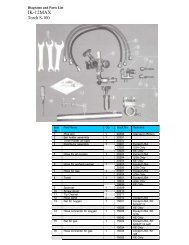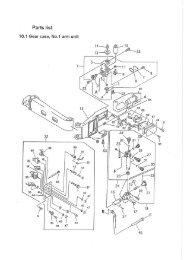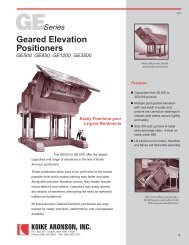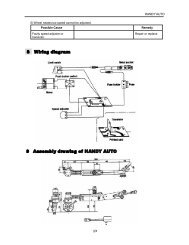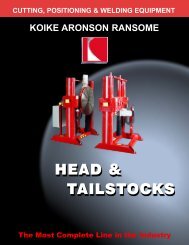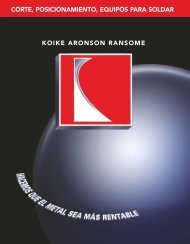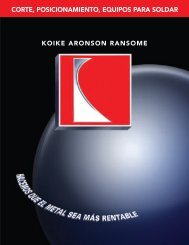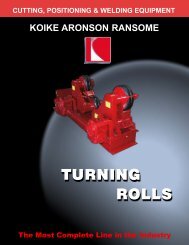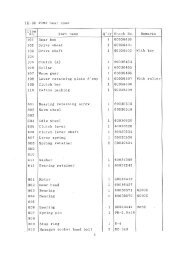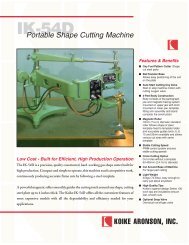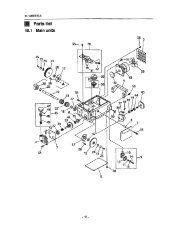Positioneering Workbook - Koike
Positioneering Workbook - Koike
Positioneering Workbook - Koike
You also want an ePaper? Increase the reach of your titles
YUMPU automatically turns print PDFs into web optimized ePapers that Google loves.
Why Use a Positioner<br />
You should use a positioner because welds made in the flat<br />
or slightly downhand position are made faster, better, cheaper,<br />
and in many cases safer than out-of-position welds. Without the<br />
use of a positioner, welds made in the vertical or overhead position<br />
are commonly deposited at the relatively low rate of as little<br />
as 3 pounds per hour. When properly positioned deposition<br />
rates can easily exceed 10 pounds per hour, depending of<br />
course on the thickness and mass of the parts being welded. The<br />
use of automatic process equipment can eliminate the need for<br />
the operator to hold the arc further increasing productivity. Positioned<br />
welds look better and quality is more easily controlled requiring<br />
less operator skill and producing less fatigue. Of course,<br />
it is possible to make positioned welds without using a positioner.<br />
Small weldments can be clamped in a vise, large ones moved<br />
with a crane. But these simplified methods seldom allow the ideal<br />
position to be attained, and are much more time consuming and<br />
hazardous to employ. Probably the first step toward the production<br />
of low cost, efficient welded products lies in the design of the<br />
weldment. But the second step (even ahead of welding process<br />
selection) is USE A POSITIONER. Put your self (and your weldment)<br />
in a good position for increased profits.<br />
What does a positioner do?<br />
First, of course, it provides a means to place the weldment in<br />
the ideal position for downhand welding. But sometimes a positioner<br />
performs another important function: it provides the weld<br />
travel speed by securing a welding head in a fixed position and<br />
allowing the positioner to move the part. This eliminates the operator<br />
variable, and is another major step toward better welds.<br />
Positioners are manufactured in various styles and configurations<br />
to accommodate different weldments and procedures :<br />
Universal Balance<br />
The Universal Balance Positioner allows the weldment to be<br />
mounted so that it can be moved by hand about its own center of<br />
gravity. Universal Balance Positioners can also be equipped<br />
with powered faceplate rotation for powered circumferential<br />
welds. They range in load capacity from 25 to 4000 lbs.<br />
Special Utility<br />
This group includes various small Positioners including<br />
non-balanced bench mounted units and floor bench mounted<br />
units with powered faceplate rotation. Their application is similar<br />
to the Universal Balance, except that the load is not balanced<br />
about its center-of-gravity. They would be selected for<br />
smaller, lighter loads, usually under 500 lbs.<br />
Gear Driven Positioner<br />
This type provides powered rotation of a work-piece, and in<br />
addition gives powered gear driven control of the table tilt. The<br />
table can be tilted from horizontal, through vertical to 45 degrees<br />
past the vertical. This type is often called a “Flat - 135<br />
degree” Positioner. Powered table rotation is variable speed to<br />
permit making circumferential welds at any desired speeds.<br />
Gear driven positioners are offered from 1,000 lbs. to<br />
1,000,000 lbs. capacity. Various accessories extend the versatility<br />
of these units.<br />
Headstock/Tailstocks<br />
These units permit long work-pieces to be mounted between<br />
centers and turned. Headstocks permit a work-piece to<br />
be turned at controlled speed about a horizontal axis. When<br />
used with a Tailstock, the combination forms a welding lathe.<br />
Since a Headstock/Tailstock combination is normally not<br />
mounted in precision alignment like an engine lathe, it is important<br />
that the means used to mount the work-piece allow a small<br />
amount of “float” or angular misalignment.<br />
Floor Turntables<br />
The Floor Turntable Positioner allows a weldment to be<br />
rotated about the vertical axis just a few feet off the floor. Variable<br />
Speed powered rotation is standard.<br />
Turning Rolls<br />
This device provides rotation of long cylindrical workpieces<br />
such as tanks and cylinders for making circumferential<br />
welds.<br />
Manipulators<br />
Where a positioner positions the work-piece, a manipulator<br />
positions the welding head over the work-piece. It provides<br />
various combinations of lift (vertical motion of the head), reach<br />
(horizontal motion of the head), or kingpin rotation (rotation of<br />
the entire manipulator on vertical axis through the mast). The<br />
various motions are available either powered or manual, and<br />
powered versions may be fixed speed or variable.<br />
4



